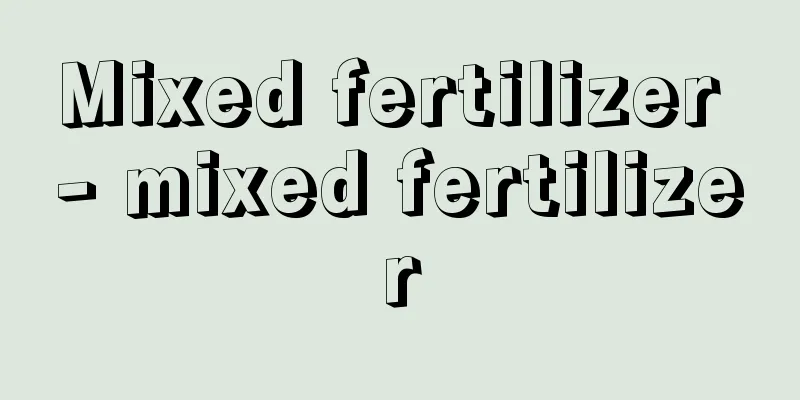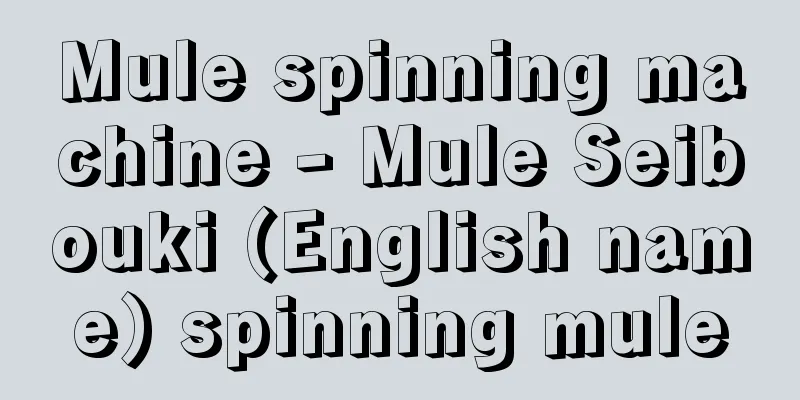Mixed fertilizer - mixed fertilizer

|
A fertilizer that contains two or more types of fertilizer and contains two or more of the three elements of fertilizer: nitrogen, phosphorus, and potassium. There are two types, which are mixed evenly with a mixer and those that are mixed by hand with a shovel. Most of them are made from organic fertilizers, but some contain trace elements such as manganese, magnesium oxide, and boron. Chemical fertilizers are similar to compound fertilizers, but they are not simply mixed or mixed mechanically like compound fertilizers, but are produced by chemical operations and generally contain higher amounts of ingredients than compound fertilizers. Currently, both are unified as first-class compound fertilizers, and there is no clear distinction between them. Compound fertilizers are characterized by the fact that each prefecture determines appropriate standards as standard compound fertilizers according to the differences in soil and the types of crops in each region, and they are produced based on these standards. Depending on the method of mixing, the fertilizer effect can be adjusted, the labor required for fertilization can be reduced, and the fertilizer can be spread evenly. Therefore, there are many brands, and the production volume per brand is small. While chemical fertilizers are mainly used for rice cultivation, compound fertilizers are mainly used for vegetables, fruit trees, and horticulture. Fertilizers that contain two or more types of granular fertilizers are called granular mixed fertilizers or bulk blended fertilizers (BB fertilizers). The advantage of BB fertilizers is that they are easy to handle because all the raw fertilizers are granular. [Yuki Koyama] "Fertilizer Handbook, 5th Edition, edited by Date Noboru and Shiozaki Hisao (1997, Rural Culture Association)" ▽ "Fertilizer Yearbook, various editions, edited by the Fertilizer Association Newspaper Division (Fertilizer Association)" [Reference items] | |Source: Shogakukan Encyclopedia Nipponica About Encyclopedia Nipponica Information | Legend |
|
2種類以上の肥料を配合したもので、肥料の三要素である窒素、リン酸、カリ(カリウム)のうち2成分以上を含むものをいう。配合機で均一に混ぜたものと、シャベルを用いた手配合のものがある。大部分が有機質の肥料を原料としているが、マンガン、苦土(酸化マグネシウム)、ホウ素など微量元素を加えたものもある。配合肥料に類似のものに化成肥料があるが、これは配合肥料のように単に機械的に配合ないし混合したものではなく、化学的操作によって製造したものであり、配合肥料に比べ含有成分量が一般に高い。現在では両者は第一種複合肥料に統一され、明白な区別はなくなっている。配合肥料は、地方ごとの土壌の違いや作物の種類に応じて、各都道府県で標準配合肥料として適切な基準が決められており、この基準に基づいて製造されるのが特徴で、配合の仕方によって、肥効の調節、施肥労力の軽減、均一な散布ができる。したがって数多くの銘柄があり、一銘柄当りの生産量は少ない。化成肥料が稲作中心であるのに対し、配合肥料は野菜用、果樹用、園芸用などが主体となっている。粒状肥料を2種類以上配合した肥料を、粒状配合肥料またはバルクブレンド肥料(BB肥料)という。その特長は原料肥料はすべて粒状肥料を使うので、取扱いが容易なことである。 [小山雄生] 『伊達昇・塩崎尚郎編著『肥料便覧』第5版(1997・農山漁村文化協会)』▽『肥料協会新聞部編『肥料年鑑』各年版(肥料協会)』 [参照項目] | |出典 小学館 日本大百科全書(ニッポニカ)日本大百科全書(ニッポニカ)について 情報 | 凡例 |
<<: Mixture change - Mixture change
>>: Compost - Haigodo (English spelling)
Recommend
Communicable disease - densenbyo (English spelling)
A general term for diseases in which a pathogen s...
Kenya [Mountain] - Kenya
An extinct volcano located in central Kenya, East ...
Gabo, Naum
Born: August 5, 1890, Bryansk [Died] August 23, 19...
About - About
[1] [noun] (formerly "hoto") a word expr...
sea-monk
…In the legend, they are femme fatales who bring ...
Omphalodes
...A perennial plant of the family Violaceae that...
Folding (bookbinding) - Ori
...It is the process of gathering sheets of paper...
Mr. Abe - Abeuji
One of the surnames of hereditary feudal lords an...
Kanose [town] - Kanose
A former town in the midstream of the Agano River ...
East Asian League - Touarenmei
An organization under the guidance of Ishihara Ka...
Writing out - Writing out
In paleography, this refers to the beginning of a...
Wang Qin-ruo (English spelling)
[Birth] Kenryu 3 (962) [Died] Tensei 3 (1025) A Ch...
Socialist Education Movement (English: Socialist Education Movement)
China's General Review Movement, which took pl...
Archery - Kyūjūtsu
〘 noun 〙 One of the martial arts. The technique of...
Buddleja curviflora (English spelling) Buddleja curviflora
…[Mr. Makoto Fukuoka]. … *Some of the terminology...









